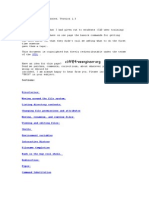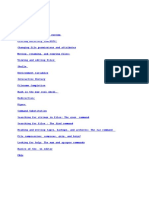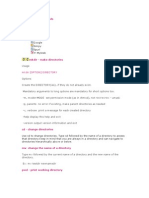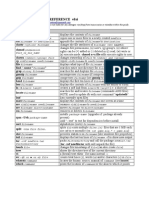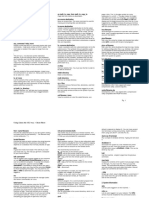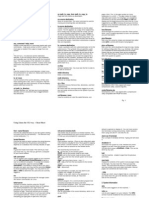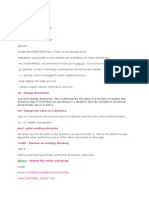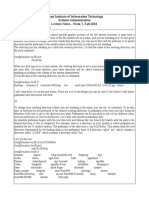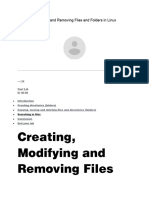0 ratings0% found this document useful (0 votes)
39 viewsBasic Linux Commands
This document provides descriptions of basic Linux commands including cat, cd, cp, dd, df, less, ln, locate, logout, ls, more, mv, pwd, shutdown, and whereis. It lists the command syntax and examples to explain what each command is used for such as viewing file contents, changing directories, copying files, checking disk space, paging through files, creating symbolic links, locating files, logging out, listing files, moving/renaming files, showing the current working directory, shutting down the system, and locating where a command is installed.
Uploaded by
Shams SiddiquiCopyright
© Attribution Non-Commercial (BY-NC)
Available Formats
Download as DOC, PDF, TXT or read online on Scribd
0 ratings0% found this document useful (0 votes)
39 viewsBasic Linux Commands
This document provides descriptions of basic Linux commands including cat, cd, cp, dd, df, less, ln, locate, logout, ls, more, mv, pwd, shutdown, and whereis. It lists the command syntax and examples to explain what each command is used for such as viewing file contents, changing directories, copying files, checking disk space, paging through files, creating symbolic links, locating files, logging out, listing files, moving/renaming files, showing the current working directory, shutting down the system, and locating where a command is installed.
Uploaded by
Shams SiddiquiCopyright
© Attribution Non-Commercial (BY-NC)
Available Formats
Download as DOC, PDF, TXT or read online on Scribd
You are on page 1/ 3
Basic Linux Commands
Command Example Description
cat Sends file contents to standard output.
This is a way to list the contents of short
files to the screen. It works well with
piping.
cat .bashrc Sends the contents of the ".bashrc" file to
the screen.
cd Change directory
cd /home Change the current working directory
to /home. The '/' indicates relative to root,
and no matter what directory you are in
when you execute this command, the
directory will be changed to "/home".
cd httpd Change the current working directory to
httpd, relative to the current location
which is "/home". The full path of the
new working directory is "/home/httpd".
cd .. Move to the parent directory of the
current directory. This command will
make the current working directory
"/home.
cd ~ Move to the user's home directory which
is "/home/username". The '~' indicates the
users home directory.
cp Copy files
cp myfile yourfile Copy the files "myfile" to the file
"yourfile" in the current working
directory. This command will create the
file "yourfile" if it doesn't exist. It will
normally overwrite it without warning if
it exists.
cp -i myfile yourfile With the "-i" option, if the file "yourfile"
exists, you will be prompted before it is
overwritten.
cp -i /data/myfile . Copy the file "/data/myfile" to the current
working directory and name it "myfile".
Prompt before overwriting the file.
cp -dpr srcdir destdir Copy all files from the directory "srcdir"
to the directory "destdir" preserving links
(-p option), file attributes (-p option), and
copy recursively (-r option). With these
options, a directory and all it contents can
be copied to another directory.
dd Disk duplicate. The man page says this
command is to "Convert and copy a file",
dd if=/dev/hdb1 but although used by more advanced
of=/backup/ users, it can be a very handy command.
The "if" means input file, "of" means
output file.
df Show the amount of disk space used on
each mounted filesystem.
less Similar to the more command, but the
user can page up and down through the
less textfile
file. The example displays the contents of
textfile.
ln Creates a symbolic link to a file.
ln -s test symlink Creates a symbolic link named symlink
that points to the file test Typing "ls -i
test symlink" will show the two files are
different with different inodes. Typing "ls
-l test symlink" will show that symlink
points to the file test.
locate A fast database driven file locator.
slocate -u This command builds the slocate
database. It will take several minutes to
complete this command. This command
must be used before searching for files,
however cron runs this command
periodically on most systems.
locate whereis Lists all files whose names contain the
string "whereis".
logout Logs the current user off the system.
ls List files
ls List files in the current working directory
except those starting with . and only
show the file name.
ls -al List all files in the current working
directory in long listing format showing
permissions, ownership, size, and time
and date stamp
more Allows file contents or piped output to be
sent to the screen one page at a time.
more /etc/profile Lists the contents of the "/etc/profile" file
to the screen one page at a time.
ls -al |more Performs a directory listing of all files
and pipes the output of the listing through
more. If the directory listing is longer
than a page, it will be listed one page at a
time.
mv Move or rename files
mv -i myfile yourfile Move the file from "myfile" to "yourfile".
This effectively changes the name of
"myfile" to "yourfile".
mv -i /data/myfile . Move the file from "myfile" from the
directory "/data" to the current working
directory.
pwd Show the name of the current working
directory
more /etc/profile Lists the contents of the "/etc/profile" file
to the screen one page at a time.
shutdown Shuts the system down.
shutdown -h now Shuts the system down to halt
immediately.
shutdown -r now Shuts the system down immediately and
the system reboots.
whereis Show where the binary, source and
manual page files are for a command
whereis ls Locates binaries and manual pages for
the ls command.
Editors: emacs, vi, pico, jed, vim
You might also like
- Basic Linux Commands: Command Example Description CatNo ratings yetBasic Linux Commands: Command Example Description Cat4 pages
- Sections:: Command Command Command,, and and Commands EditorNo ratings yetSections:: Command Command Command,, and and Commands Editor18 pages
- Deploying Websites - Command Line For Building Websites Cheatsheet - CodecademyNo ratings yetDeploying Websites - Command Line For Building Websites Cheatsheet - Codecademy2 pages
- Basic Linux Comman C Mkdir - Make DirectoriescNo ratings yetBasic Linux Comman C Mkdir - Make Directoriesc7 pages
- Basic Linux Commands: Mkdir - Make DirectoriesNo ratings yetBasic Linux Commands: Mkdir - Make Directories5 pages
- Basic Linux Commands Mkdir - Make DirectoriesNo ratings yetBasic Linux Commands Mkdir - Make Directories5 pages
- Barani Institute of Information Technology Systems Administration Lecture Notes - Week 7, Fall 2018No ratings yetBarani Institute of Information Technology Systems Administration Lecture Notes - Week 7, Fall 20186 pages
- Introduction To Linux: Alan Orth April 17, 2010 ILRI, NairobiNo ratings yetIntroduction To Linux: Alan Orth April 17, 2010 ILRI, Nairobi27 pages
- Fundamentals, Linux/Unix Commands, Regular Expressions, Variables, VI EditorNo ratings yetFundamentals, Linux/Unix Commands, Regular Expressions, Variables, VI Editor12 pages
- The Basic Linux Commands: Mkdir - Make DirectoriesNo ratings yetThe Basic Linux Commands: Mkdir - Make Directories8 pages
- Pharmsci571-Cadd: Essential Linux Commands: Some Important General Unix NotesNo ratings yetPharmsci571-Cadd: Essential Linux Commands: Some Important General Unix Notes11 pages
- Notes On Linux Operating System: Written by Jan Mrázek For The MIBO (BCMB) 8270L Course Last Updated: Jan 9, 2007No ratings yetNotes On Linux Operating System: Written by Jan Mrázek For The MIBO (BCMB) 8270L Course Last Updated: Jan 9, 20074 pages
- Ansible by Examples: 200+ Automation Examples For Linux and Windows System Administrators and DevOpsFrom EverandAnsible by Examples: 200+ Automation Examples For Linux and Windows System Administrators and DevOpsNo ratings yet
- Quick Configuration of Openldap and Kerberos In Linux and Authenicating Linux to Active DirectoryFrom EverandQuick Configuration of Openldap and Kerberos In Linux and Authenicating Linux to Active DirectoryNo ratings yet
- Extra Programs: Enter A The Mark of Your 6 SujectsNo ratings yetExtra Programs: Enter A The Mark of Your 6 Sujects3 pages








